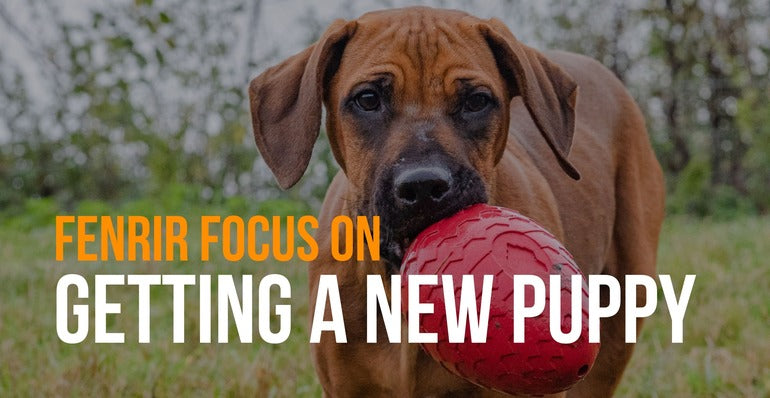How To Prepare For A New Puppy?
If you are planning to get a new puppy, we congratulate you: Sharing your home with a sweet, cuddly little canine is an amazing experience. But many first-time dog owners are unsure about how to best prepare for their dog’s arrival. In this article, we will give you our answer to the common question “What can I do to prepare for my puppy?”
What To Buy Before Bringing Your Puppy Home?
1. The Crate
In our opinion and experience, crates are wonderful tools for raising puppies. We recommend equipping the crate with a cosy dog-bed, and partially cover it with a light blanket. In this way, you create an inviting, den-like space. Most puppies happily accept their crate as their designated sleeping place. By giving our new puppy this place of refuge, we help them to relax into their new situation. At the same time, crate training helps them to learn where to go potty, and where not. After all, dogs instinctually avoid soiling their dens. We advise taking them to their designated bathroom area every hour, on the hour – as well as right after their naps and mealtimes.
2. Safe Puppy-Toys
Puppies love to chew. And to avoid any damage to our clothes, carpets or furniture, we want to redirecting their mouthing and gnawing to safe objects. This is where puppy toys come in. By providing a selection of different toys, we stimulate our puppy’s minds. Durable toys such as our fillable Fenrir Hammer are perfect for alleviate the teething discomfort experienced by young dogs. The Hammer provides fun and entertainment – especially when filled with peanut butter for dogs, wet puppy food, or meat paste. Filled and then frozen, the Hammer keeps puppies entertained for quite a while. The Fenrir Hammer is an extremely versatile toy that your dog can enjoy in various ways: Virtually indestructible and easy to clean, the Fenrir Hammer is an excellent treat-dispenser, chew toy, retrieval dummy and tug toy.
3. Healthy Puppy-Food
Good nutrition is very important for dogs of any age. But puppies in particular have a lot of growing to do: Depending on their size and breed, young dogs take anything from 9 months to 3 years to fully mature. Low-quality nutrition during a dog’s puppyhood and adolescence can lead to irreparable health problems. To prevent any kind of dysplasia or limb deformities in the future, we highly recommend investing in high-quality nutrition. Ask your vet to advise you on which type of food is best for your dog. For the first few weeks, however, you should give them the same food they have received at the breeder, or the shelter. If your vet recommends transitioning your puppy to a different kind of food after that, do so gradually over the course of one week.
4. Leashes And Collars
Having a good, functional, leash & collar combo is a must for puppy owners. We recommend choosing a light leash designed for puppies, in combination with a safe flat collar. With its soft, padded interior, our Ragnar Collar, for example, is very comfortable for dogs. Available in all sizes, the Ragnar Collar’s lightweight-design makes it ideal for puppies. You can leave it on the dog throughout the day – without causing them any discomfort. Having a collar on your puppy allows you to easily grab them whenever you need to. Also, you can quickly clip any leash into the metal D-ring connection point of the Ragnar Collar.
5. Other Products For Puppies
Other useful items to buy before bringing home your puppy include:
✓ Brushes and combs
✓ Food- and water bowls
✓ Nail-clippers
✓ Puppy pads
✓ Cotton-balls and ear-cleaning drops
✓ A play-pen
✓ Baby-gates
✓ Comfortable dog blankets and dog beds
✓ Treats
✓ A transport box, safety grid, or safety harness for road trips
If in any doubt about what to get for your puppy, ask your vet for recommendations. We also recommend setting up an introductory vet-appointment for them. This initial appointment should be a purely social visit. Its aim is to condition your puppy to associate vet visits with being petted and receiving treats - and not with being poked and prodded.
How To Puppy-Proof Your Home?
Puppy-proofing your living space is one of the most important things you can do for your new dog. The extent of such safety-measures largely depends on the areas that will be accessible for your puppy. Some owners only secure the kitchen and living room – as this is the only indoor space the dog will be allowed in. Other people dog-proof their entire house and backyard. Here are some of the measures you can take to puppy-proof your home and garden:
✓ Keep your puppy out of any unsecured rooms
✓ Keep cabinets and drawers securely closed at all times, and your floors tidy (doing so prevents your puppy gaining access to socks or other smaller objects that they could swallow)
✓ Remove toxic plants from the garden
✓ Relocate toxic pot plants to spaces where the dog cannot access them
✓ Secure windows, doors, staircases, garden gates, balconies and fireplaces (for example, by using baby gates)
✓ Cover plug sockets
✓ Secure electrical cords – for example, by tying them up or covering them with a PVC pipe
✓ Keep chemicals, cleaning supplies, human food and medications in high cabinets
✓ Make the trash bin inaccessible for your puppy
✓ Put a fence around swimming pools or ponds on your property
Conclusion
There is no doubt about it: Getting a puppy is an exciting adventure. And by following the tips suggested in this article, you should have all your bases covered. If in any doubt, speak to your breeder, the pet shelter, or your vet. Now, we wish you and your new canine companion all the best. Practise calm, consistent leadership, be patient, and most importantly - enjoy the journey!

